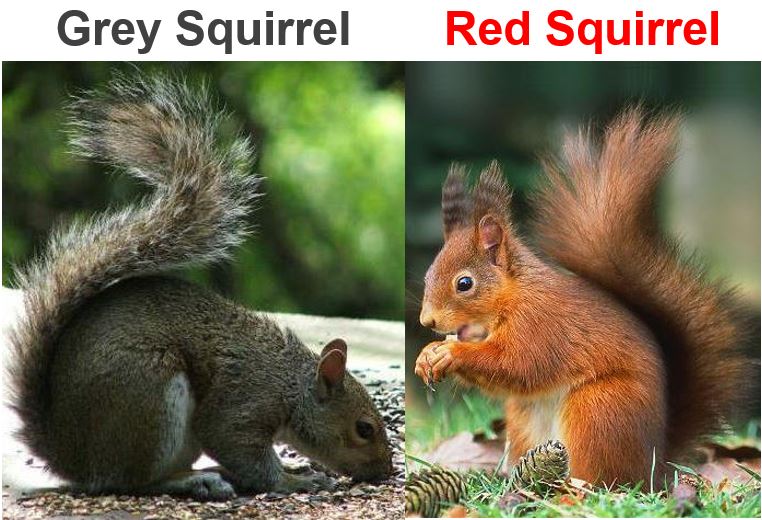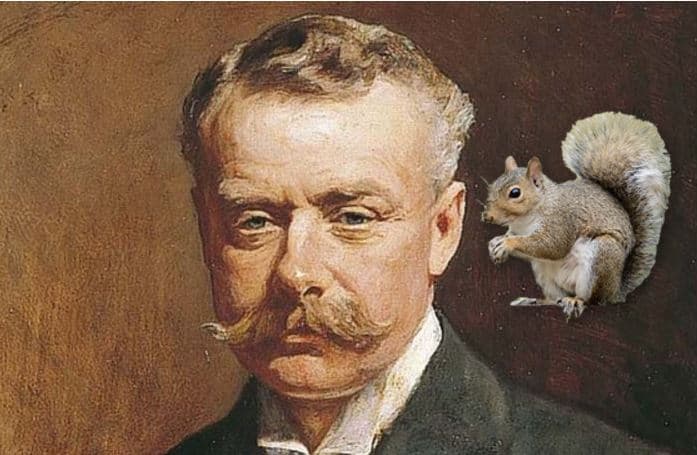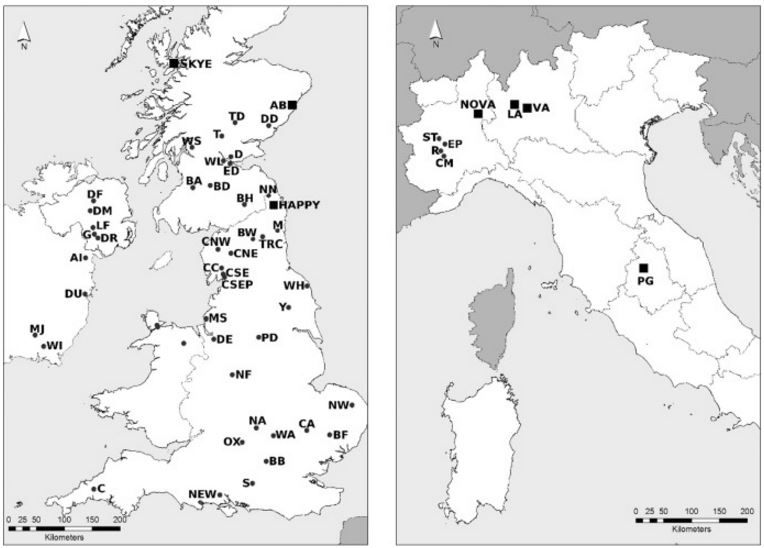All this talk of grey squirrels being master invaders is a long-held myth – humans were the ones that made them spread across the United Kingdom, a team of researchers from the UK, Italy and the US reported after compiling a squirrel DNA database.
They published details of their study and findings in two academic journals: Biological Conservation and Diversity and Distributions.
Before the 1890s, the UK just had red squirrels. Grey squirrels were imported from North America. The traditional view has been that they were super-able to cope with new landscapes and spread across the UK rapidly, driving the red squirrel out of its habitat and eating all its food. In other words, we all saw them as supreme invaders.
 Greys out-compete red squirrels for food and resources, and can transmit Squirrelpox Virus (which is lethal to reds but does not affect greys). However, human intervention is the main reason for the grey’s huge success in the British Isles. (Image: adapted from berwickwildlifegroup.org.uk)
Greys out-compete red squirrels for food and resources, and can transmit Squirrelpox Virus (which is lethal to reds but does not affect greys). However, human intervention is the main reason for the grey’s huge success in the British Isles. (Image: adapted from berwickwildlifegroup.org.uk)
Interbreeding not common
There was also the belief that different grey squirrel populations interbred and produced super-squirrels that were even better able to adapt and spread. This also appears to have been a myth.
According to new research, grey squirrels are not as tough as once believed, and were helped much more by humans in their conquest of Britain.
Dr. Lisa Signorile, from Imperial College London, compiled a DNA database of almost 1,500 grey squirrels in Britain and Italy during her PhD studies at the Zoological Society of London and Imperial College London.
Her results show that different squirrel populations are still genetically distinct – in other words, they did not interbreed like we thought and no super-squirrel was created.
As the squirrel populations were distinct, it meant Dr. Signorile and colleagues were able to trace where those in new areas had come from.
The researchers discovered that many new populations of grey squirrels are not related to populations nearby, but appear to have come from a long way away. For example, the grey squirrels in Aberdeen are more closely related to populations around the New Forest area in Hampshire (southern England) than other populations in Scotland.
How could this have happened? The only explanation is that humans transported them.
 Herbrand Arthur Russell, 11th Duke of Bedford (1858-1940), a conservationist and animal lover who was President of the Zoological Society of London, helped the grey squirrel spread across the UK. He was not aware that his actions contributed to the demise of the red squirrel. (Image: adapted from bedfordestates.com)
Herbrand Arthur Russell, 11th Duke of Bedford (1858-1940), a conservationist and animal lover who was President of the Zoological Society of London, helped the grey squirrel spread across the UK. He was not aware that his actions contributed to the demise of the red squirrel. (Image: adapted from bedfordestates.com)
Grey squirrels are poor invaders
Dr Signorile said:
“It has been thought since the 1930s that grey squirrels were all the same, spreading across the country as one invasion front. After a century, genetics has proved that this isn’t correct. They are not that good at breeding and mixing – in fact there are clear signs of inbreeding.”
“Grey squirrels are not as crazy invaders as we think – their spread is far more our own fault.”
According to Dr. Signorile, one of the worst offenders in helping squirrels spread across the UK was the 11th Duke of Bedford, Herbrand Russel. He was involved in several successful animal conservation schemes, but released and gave away a large number of grey squirrels around Britain from his home at Woburn Park.
 UK and Italy maps indicating the geographic position of all the sampled eastern grey squirrels forming the DNA database. (Image: sciencedirect.com)
UK and Italy maps indicating the geographic position of all the sampled eastern grey squirrels forming the DNA database. (Image: sciencedirect.com)
Russel probably caused the London epidemic of grey squirrels, after releasing populations in Regent’s Park.
Dr. Signorile said:
“It was a time when we didn’t know invasive species could cause so much damage.”
Grey squirrels outcompete reds
Even though greys are not as good invaders as we had previously believed, they still outcompete native red squirrels for resources, and carry diseases that are harmful to reds but not to greys.
In England and Wales, reds have been largely displaced by greys. Dr. Signorile says that control and eradication programmes are still needed, especially in areas were red squirrels still exist.
Scotland is the last place where grey squirrels have yet to take over completely. However, humans, without realizing it, are helping them succeed in their conquest. Dr. Signorile and colleagues also investigated where the recently-spotted greys originate from.
One grey that was captured in the Isle of Skye in 2010 had come from Glasgow. Its genetic profile confirmed that the squirrel had stowed away under the bonnet of a car and escaped on Skye.
Grey squirrels in Italy
Dr. Signorile also investigated some grey squirrel populations in Italy, where they are a more recent introduction. Until 2012, they were sold in the country as pets.
Her analysis of different Italian regions confirmed an illegal trade in grey squirrels. “It illustrates that ‘attractive and cute’ species are often spread further by people,” explained Dr Signorile.
Stopping the spread
Apart from showing to us that the grey squirrel’s success in the UK is mainly due to human intervention, the study also suggests that new approaches are needed to stop their spread, the authors wrote.
Dr. Signorile said:
“We put a lot of money into controlling grey squirrel numbers, but nobody is trying to prevent their movement and discourage people from picking them up. Decision-makers should look into preventing spreading of greys by human hands.
“The public also needs to be aware of the risk of even accidentally moving squirrels. People think grey squirrels are already everywhere, so it is not a problem, but it can be, especially in areas of Scotland where there are not yet established populations.”
The authors said the findings of their genetic study could also be applied to other invasive species, especially where humans have contributed to the spread. These include the more exotic species that are considered attractive, such as ring-necked parakeets in London, and Chinese water deer.
Two citations:
1. “Using DNA profiling to investigate human-mediated translocations of an invasive species,” A.L. Signorile, D.C. Reuman, P.W.W. Lurz, S. Bertolino, C. Carbone, J. Wanga. Biological Conservation. March 2016. DOI: doi:10.1016/j.biocon.2015.12.026.
2. “Mixture or mosaic? Genetic patterns in UK grey squirrels support a human-mediated ‘long-jump’ invasion mechanism,” A. L. Signorile, P.W.W. Lurz, J. Wang, D.C. Reuman and C. Carbone. Diversity and Distributions. 10 January 2016. DOI: 10.1111/ddi.12424.
Video – Red Squirrel Sanctuary
